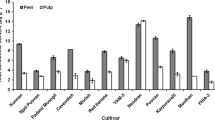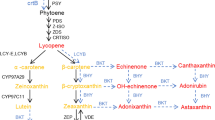Abstract
Using a previously reported optimized Agrobacterium tumefaciens-mediated transformation protocol, a watermelon phytoene synthase-C (PSY-C) gene was introduced into the elite honeydew breeding line ‘150’. Putative transformants were selected on kanamycin-containing medium (from 150 to 50 mg·l−1) and presence of the transgene was confirmed using polymerase chain reaction (PCR). Moreover, Southern blot analysis confirmed integration of the transgene and revealed presence of one to two copies of the PSY-C transgene in the different transgenic lines. In addition, reverse transcription (RT)-PCR analysis revealed transcript levels of the transgene in different tissues of these transgenic lines. Using flow cytometric analysis, it was found that all T0 transgenic plants were tetraploid. Moreover, altered phenotypes (color change) were observed for rind tissues of transgenic lines. Based on high performance liquid chromatography (HPLC), β-carotene content and phytoene accumulation in fruit of transgenic lines were 32-fold and 11 μg·g−1 FW higher than the levels found in the control plants.



Similar content being viewed by others
Abbreviations
- PCR:
-
Polymerase chain reaction
- HPLC:
-
High performance liquid chromatography
- PG:
-
Polygalacturonase
- PSY:
-
Phytoene synthase
- T0 :
-
Regenerated transgenic plant from the original inoculated explant
- T1 :
-
The progeny of the original T0 transgenic plants
References
Aggelis A, John I, Grierson D (1997) Analysis of physiological and molecular changes in melon (Cucumis melo L.) varieties with different rates of ripening. J Exp Bot 48:769–778
Aluru M, Xu Y, Guo R, Wang Z, Li S, White W, Wang K, Rodermel S (2008) Generation of transgenic maize with enhanced provitamin A content. J Exp Bot 59:3551–3562
Ayub R, Guis M, Amor MB, Gillot L, Roustan JP, Latché A, Bouzayen M, Pech JC (1996) Expression of ACC oxidase antisense gene inhibits ripening of cantaloupe melon fruits. Nat Biotechnol 14:862–866
Bang H, Kim S, Leskovar DI, Davis AR, King SR (2006) Duplication of the phytoene synthase gene in the carotenoid biosynthetic pathway of watermelon. HortScience 41:1007 (abstract)
Bird CR, Smith CJS, Ray JA, Moureau P, Bevan MW, Bird AS, Huges S, Morris PC, Grierson D, Schuch W (1988) The tomato polygalacturonase gene and ripening-specific expression in transgenic plants. Plant Mol Biol 11:651–662
Clendennen S, Kellogg JA, Wolf KA, Matsumura W, Peters S, Vanwinkle JE, Copes B, Pieper M, Kramer MG (1999) Genetic engineering of cantaloupe to reduce ethylene biosynthesis and control ripening. In: Kanellis A, Chang C, Klee H, Bleecker AB, Pech JC, Grierson D (eds) Biology and biotechnology of the plant hormone ethylene, vol II. Kluwer, Dordrecht, pp 371–379
Clough GH, Hamm PB (1995) Coat protein transgenic resistance to watermelon mosaic and zucchini yellows mosaic-virus in squash and cantaloupe. Plant Dis 79:1107–1109
Cunningham FX Jr, Gantt E (1998) Genes and enzymes of carotenoid biosynthesis. Annu Rev Plant Physio Plant Mol Biol 49:557–583
Curuk S, Ananthakrishnan G, Singer S, Xia X, Elman C, Nestel D, Cetiner S, Gaba V (2003) Regeneration in vitro from the hypocotyl of Cucumis species produces almost exclusively diploid shoots, and does not require light. HortScience 38:105–109
Dhooghe E, van Laere K, Eeckhaut T, Leus L, van Huylenbroeck J (2011) Mitotic chromosome doubling of plant tissues in vitro. Plant Cell Tiss Organ Cult 104:359–373
Diretto G, Al-Babili S, Tavazza R, Papacchioli V, Beyer P, Giuliano G (2007) Metabolic engineering of potato carotenoid content through tuber-specific overexpression of a bacterial mini-pathway. PLoS ONE 2:e350
Ducreux LJM, Morris WL, Hedley PE, Shepherd T, Davies HV, Millam S, Taylor MA (2005) Metabolic engineering of high carotenoid potato tubers containing enhanced levels of beta-carotene and lutein. J Exp Bot 56:81–89
Ezura H, Hiroshi A, Keiko Y, Oosawa K (1992) Highly frequent appearance of tetraploidy in regenerated plants, a universal phenomemon, in tissue cultures of melon (Cucumis melo L.). Plant Sci 85:209–213
Ezura H, Hitomi A, Higashi K, Sato T, Kubota M (1997a) Introduction of ACC synthase antisense gene to muskmelon (Cucumis melo L. var. reticulatus). In: Abak K, Büyükalaca S (eds) First international symposium on cucurbits, Adana, Turkey, Abstract
Ezura H, Kikuta I, Oosawa K (1997b) Long-term ploidy stability of shoot primordium cultures and produced plants of melon. Plant Cell Tiss Organ Cult 48:31–35
Fan J, He Q, Wang X, Yu X (2007) Antisense acid invertase (anti-MAI1) gene alters soluble sugar composition and size in transgenic muskmelon fruits. Acta Hort Sinica 34:677–682
Fang G, Grumet R (1993) Genetic-engineering of potyvirus resistance using constructs derived from the zucchini yellow mosaic virus coat protein gene. Mol Plant-Microbe Interact 6:358–367
Fraser PD, Bramley PM (2004) The biosynthesis and nutritional uses of carotenoids. Prog Lipid Res 43:228–265
Fraser PD, Römer S, Kiano JW, Shipton CA, Mills PB, Drake R, Schuch W, Bramley PM (2001) Elevation of carotenoids in tomato by genetic manipulation. J Sci Food and Agri 81:822–827
Fraser PD, Römer S, Shipton CA, Mills PB, Kiano JW, Misawa N, Drake RG, Schuch W, Bramley PM (2002) Evaluation of transgenic tomato plants expressing an additional phytoene synthase in a fruit-specific manner. Proc Natl Acad Sci USA 99:1092–1097
Fray RG, Grierson D (1993) Identification and genetic analysis of normal and mutant phytoene synthase genes of tomato by sequencing, complementation and co-suppression. Plant Mol Biol 22:589–602
Fuchs M, McFerson JR, Tricoli DM, McMaster JR, Deng RZ, Boeshore ML, Reynolds JF, Russell PF, Quemada HD, Gonsalves D (1997) Cantaloupe line CZW-30 containing coat protein genes of cucumber mosaic virus, zucchini yellow mosaic virus, and watermelon mosaic virus-2 is resistant to these three viruses in the field. Mol Breed 3:279–290
Gallagher CE, Matthews PD, Li F, Wurtzel ET (2004) Gene duplication in the carotenoid biosynthetic pathway preceded evolution of the grasses (Poaceae). Plant Physiol 135:1776–1783
Gonsalves C, Xue B, Yepes M, Fuchs M, Ling KS, Namba S, Chee P, Slightom JL, Gonsalves D (1994) Transferring cucumber mosaic virus-white leaf strain coat protein gene into Cucumis melo L. and evaluating transgenic plants for protection against infections. J Amer Soc Hort Sci 119:345–355
Guis M, Botondi R, BenAmor M, Ayub R, Bouzayen M, Pech JC, Latche A (1997) Ripening-associated biochemical traits of cantaloupe charentais melons expressing an antisense ACC oxidase transgene. J Am Soc Horticult Sci 122:748–751
Guis M, Amor MB, Latché A, Pech JC, Roustan JP (2000) A reliable system for the transformation of cantaloupe charentais melon (Cucumis melo L. var. cantalupensis) leading to a majority of diploid regenerants. Scientia Hort 84:91–99
Hao J, Niu Y, Yang B, Gao F, Zhang L, Wang J, Hasi A (2011) Transformation of a marker-free and vector-free antisense ACC oxidase gene cassette into melon via the pollen-tube pathway. Biotechnol Lett 33:55–61
Hood EE, Gelvin SB, Melchers LS, Hoekema A (1993) New Agrobacterium helper plasmids for gene transfer to plant. Transgenic Res 2:208–218
Karvouni Z, John I, Taylor JE, Watson CF, Turner AJ, Grierson D (1995) Isolation and characterization of a melon cDNA clone encoding phytoene synthase. Plant Mol Bio 27:1153–1162
Lau JM, Cooper NG, Robinson DL, Korban SS (2009) Sequence and in silico characterization of the tomato polygalacturonase (PG) promoter and terminator regions. Plant Mol Biol Rep 27:250–256
Lema-Rumińska J (2011) Flow cytometric analysis of somatic embryos, shoots, and calli of the cactus Copiapoa tenuissima Ritt. forma monstruosa. Plant Cell Tiss Organ Cult 106:531–535
Li Z, Yao L, Yang Y, Li A (2006) Transgenic approach to improve quality traits of melon fruit. Sci Hort 108:268–277
Li F, Vallabhaneni R, Wurtzel ET (2008) PSY3, a new member of the phytoene synthase gene family conserved in the Poaceae and regulator of abiotic stress-induced root carotenogenesis. Plant Physiol 146:333–1345
Montgomery J, Pollard V, Deikman J, Fischer RL (1993) Positive and negative regulatory regions control the spatial distribution of polygalacturonase transcription in tomato fruit pericarp. Plant Cell 5:1049–1062
Murashige T, Skoog F (1962) A revised medium for rapid growth and bio assays with tobacco tissue cultures. Physiol Plant 15:473–497
Nicholass FJ, Smith CJS, Schuch W, Bird CR, Grierson D (1995) High levels of ripening-specific reporter gene expression directed by tomato fruit polygalacturonase gene-flanking regions. Plant Mol Biol 28:423–435
Nuňez-Palenius HG, Cantliffe DJ, Huber DJ, Ciardi J, Klee HJ (2006) Transformation of a muskmelon ‘Galia’ hybrid parental line (Cucumis melo L. var. reticulatus Ser.) with an antisense ACC oxidase gene. Plant Cell Rep 25:198–205
Nuňez-Palenius HG, Grumet R, Lester G, Cantliffe D (2008) Melon fruits: genetic diversity, physiology, and biotechnology features. Crit Rev Biotechnol 28:13–55
Ochatt SJ, Patat-Ochatt EM, Moessner A (2011) Ploidy level determination within the context of in vitro breeding. Plant Cell Tiss Organ Cult 104:329–341
Paine JA, Shipton CA, Chaggar S, Howells RM, Kennedy MJ, Vernon G, Wright SY, Hinchliffe E, Adams JL, Silverstone AL, Drake R (2005) Improving the nutritional value of Golden Rice through increased pro-vitamin A content. Nat Biotechnol 23:482–487
Qin X, Coku A, Inoue K, Tian L (2011) Expression, subcellular localization, and cis-regulatory structure of duplicated phytoene synthase genes in melon (Cucumis melo L.). Planta 234:737–748
Ren Y, Bang H, Curtis IS, Gould G, Patil BS, Crosby KM (2012) Agrobacterium-mediated transformation and shoot regeneration in elite breeding lines of western shipper cantaloupe and honeydew melons (Cucumis melo L.). Plant Cell Tiss Organ Cult 108:147–158
Shellie KC (2001) Reduced ethylene concentration and postharvest quality of transgenic netted melon (Cucumis melo L.) expressing S-adenosylmethionine hydrolase. HortScience 36:467
Shewmaker CK, Sheehy JA, Daley M, Colburn S, Ke DY (1999) Seed-specific overexpression of phytoene synthase: increase in carotenoids and other metabolic effects. Plant J 20:401–412
Silva JA, da Costa TS, Lucchetta L, Marini LJ, Zanuzo MR, Nora L, Nora FR, Twyman RM, Rombaldi CV (2004) Characterization of ripening behavior in transgenic melons expressing an antisense 1-aminocyclopropane-1-carboxylate (ACC) oxidase gene from apple. Postharvest Biol Technol 32:263–268
Skroch PW, Nienhuis J (1995) Qualitative and quantitative characterization of RAPD variation among snap bean genotypes. Theor Appl Genet 91:1078–1085
Tian H, Ma L, Zhao C, Hao H, Gong B, Yu X, Wang X (2010) Antisense repression of sucrose phosphate synthase in transgenic muskmelon alters plant growth and fruit development. Biochem and Biophys Res Commun 393:365–370
Wu H, Yu T, Raja JAJ, Wang H, Yeh SD (2009) Generation of transgenic oriental melon resistant to zucchini yellow mosaic virus by an improved cotyledon-cutting method. Plant Cell Rep 28:1053–1064
Yalçın-Mendi NY, Ipek M, Serbest-Kobaner S, Curuk S, Aka Kacar Y, Cetiner S, Gaba V, Grumet R (2004) Agrobacterium-mediated transformation of Kirkagac 637 a recalcitrant melon (Cucumis melo) cultivar with ZYMV coat protein encoding gene. Eur J Hort Sci 69:258–262
Yalçın-Mendi NY, Sari N, Akyildiz A, Solmaz I, Ünek C, Ozkaya O, Serçe S (2010) Determination of gene escape and fruit quality characteristics in transgenic melon. Turk J Agric Sci 34:135–143
Ye X, Al-Babili S, Kloti A, Zhang J, Lucca P, Beyer P, Potrykus I (2000) Engineering the provitamin A (beta-carotene) biosynthetic pathway into (carotenoid-free) rice endosperm. Sci 287:303–305
Yoshioka K, Hanada K, Nakazaki Y, Minobe Y, Yakuwa T, Oosawa K (1992) Successful transfer of the cucumber mosaic virus coat protein gene to Cucumis melo L. Jpn J Breed 42:277–285
Acknowledgments
This research was supported by the USDA-CSREES (2008-34402-19195, 2009-34402-19831) and USDA-NIFA (2010-34402-20875), “Designing Foods for Health” grants, through the Vegetable and Fruit Improvement Center, Texas AgriLife Research. We wish to thank Drs. Jim Giovannoni and Li Li at Cornell University for providing binary vectors and technical advice. We also appreciate Dr. Yong Hun Chi’s help in providing E. coli for gene construction and technical advice.
Author information
Authors and Affiliations
Corresponding author
Electronic supplementary material
Below is the link to the electronic supplementary material.
Rights and permissions
About this article
Cite this article
Ren, Y., Bang, H., Lee, E.J. et al. Levels of phytoene and β-carotene in transgenic honeydew melon (Cucumis melo L. inodorus). Plant Cell Tiss Organ Cult 113, 291–301 (2013). https://doi.org/10.1007/s11240-012-0269-8
Received:
Accepted:
Published:
Issue Date:
DOI: https://doi.org/10.1007/s11240-012-0269-8




